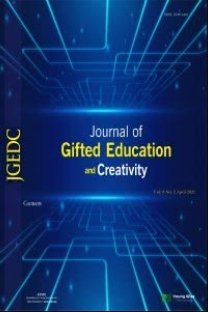Üstün Yetenekli Öğrencilerde Çoklu Yetenek Gelişiminde Etkili Olabilecek Bir Araç: Bilim Tiyatrosu
Bilim tiyatroları kavramı, bilimin kitle ve toplumla iletişim kanallarından biri olan sanat aracılığıyla yapılan şeklidir. Tarihte bilim tiyatrolarının kullanımına ilişkin harika örnekler bulunmaktadır. Bu derleme çalışmasında bu örneklerden bahsedilmiştir. Bunun yanında bilim tiyatro türlerinin neler olduğu açıklanmıştır. Bilim tiyatrolarının kullanımına ilişkin yakın zamanda önemli projeler bulunmakta olup, bu projelerle ilgili bilimsel bulgular da tartışılmıştır. Bilim tiyatroların üstün/özel yetenekli öğrencilerin eğitiminde önemli bir eğitimsel araç olarak kullanımı konusu “çoklu potansiyel” kavramıyla birlikte tartışılmıştır. Günümüzde kariyer alanlarında çoklu potansiyelin önemi, özel yetenekli öğrencilerin eğitiminde çoklu potansiyeli destekleyici eğitimsel yaklaşımların kullanımına ilişkin öngörüler bu çalışmada sunulmuştur.
Anahtar Kelimeler:
üstün/özel yetenekliler, çoklu potansiyel, bilim tiyatroları
___
- Astin, A., Green, K. C.. & Korn, W. S. (1988). The American freshman: Twenty year trends. Los Angeles: Higher Education Research Institute. Bloom. B. S. (1985). Developing talent in young people. New York: Ballantine Books.
- Bultitude, K. (2011). The why and how of science communication. In P. Rosulek (Ed.), Science communication. Pilsen, Czech Republic: European Commission.
- Conner, C.D. (2012). Halkın bilim tarihi (Çev: ). Ankara: TÜBİTAK Yayınları.
- Çalışkur, A., & Aslan, A.E. (2013). Rokeach değerler envanteri güvenirlik ve geçerlik çalışması. Balıkesir Üniversitesi Sosyal Bilimler Enstitüsü Dergisi, 16(29), 81-105.
- Frederickson. R. H., & Rothney. J. W. M. (1972). Recognizing and assisting multipotential youth. Columbus, OH: Merrill.
- Galileo, G. (1632). İki büyük dünya sistemi hakkında diyalog (Çev: Aşçıoğlu, R.). İstanbul: Türkiye İşbankası Kültür Yayınları.
- Holland, J. (1985). The Vocational Preference Inventory. Odessa, FL: Psychological Assessment Resources.
- Holland. J. (1974). Self-Directed Search. Palo Alto, CA: Consulting Psychologists Press.http://scienceplays.org/what-is-a-science-play/
- Jackson, D. N. (1974). The Personality Research Form. Odessa. FL: Psychological Assessment Resources.
- Kerr, B. A. (1981). Career education strategies for gifted and talented. Journal of Career Education, 7, 318-325. Reprinted in Chronical Guidance Professional Series, p. 994, 1982.
- Kerr, B. A. (1990). Career planning for gifted and talented youth. In BergerS. Flyer files oil gifted students Reston, VA: ERIC Clearinghouse on Handicapped and Gifted Children.
- Kerr, B. A., & Ghrist-Priebe, S. (1988). Intervention for multipotentiality. Journal of Counseling and Development, 66(8). 366-370.
- Kuhn, T. (2013). Bilimsel devrimlerin yapısı (Çev: ).
- Kuhn, Thomas, Bilimsel Devrimlerin Yapısı, çev: Nilüfer Kuyaş, Üçüncü Baskı, İstanbul, Alan Yayıncılık, 1991.
- Lanza, T., Crescimbene, M., La Longa ve D’Addezio, G., (2014). Bringing earth ınto the scene of a primary school: a science theatre experience. Science Communication, 36(1) 131–139.
- Lederman, N. G., Wade, P., and Bell, R. L. (2000). Assessing Understanding of the Nature of Science: A Historical Perspective. In W. F. McComas (Ed.), The Nature of Science in Science Education (sf. 331- 350). Dordrecht, Boston, London: Kluwer Academic Publishers.MEB, (2007). Bilim ve Sanat Merkezi Yönergesi.
- Perrone, P., Karshner, W.- & Male, R. (1979). The career development needs of talented students, University of Wisconsin (ERIC No. ED 185 731 l.)
- Rokeach, M. (1982). Rokeach Values Inventory. Sunny vale, CA: Halgren Press.
- Snow, C.P. (1959). İki Kültür (Çev: Tuncay Birkan). Ankara: TÜBİTAK yayınları.
- Terman, L. M., & Oden, M. H. (1935). The promise of youth. Genetic studies of genius, Vol. 3. Stanford: Stanford University Press.
- Terrnan, L. M., & Oden, M. H. (1947). ]'he gifted child grows LIP. Genetic studies u/genius, Vol. 4. Stanford: Stanford Universitv Press.
- Voss-Andreae J. (2017). Quantum Sculpture: Art Inspired by the Deeper Nature of Reality. In: Fenyvesi K., Lähdesmäki T. (eds) Aesthetics of Interdisciplinarity: Art and Mathematics. Birkhäuser, Cham. http://mst3k.wikia.com/wiki/Mystery_Science_Theater_3000
- Walker, G. J. (2010, December). Science theatre: A novel tool for HIV intervention in South Africa. Paper presented at the 11th International Conference on Public Communication of Science and Technology, New Delhi, India.
- Walker, G. J. (2010, December). Science theatre: A novel tool for HIV interventioin South Africa. Paper presented at the 11th International Conference on Public Communication of Science and Technology, New Delhi, India.
- Watley, D. J.. & Kaplan, R. (1970). Merit scholars and the fulfullment u/promise. Evanston, IL: National Merit Scholar Corporation. Zunker, A. (1983). Career counseling. Monterey, CA: Brooks-Cole.
- Yıldız, P. (2017). Sahne ve seyirci etkileşiminin tarihsel gelişiminde göstergebilimsel açıdan bir analiz. Selçuk Üniversitesi Sosyal Bilimler Enstitüsü Dergisi, 13, http://dergisosyalbil.selcuk.edu.tr/susbed/article/view/692/644
- Shepherd-Barr, K. (2006). Science on stage: From Doctor Faustus to Copenhagen. Princeton, New Jersey: Princeton University Press.
- Borrow, J., & Russo, P. (2015). A blueprint for public engagement appraisal: Supporting research careers. Cornell University Library.
- Yayın Aralığı: Yılda 4 Sayı
- Başlangıç: 2014
- Yayıncı: Genç Bilge Yayıncılık
Sayıdaki Diğer Makaleler
Sınıf Öğretmeni Adaylarının Yaratıcı Düşünme Becerisi Hakkındaki Görüşlerine Ait Nitel Bir Çalışma
Gülşah BATDAL KARADUMAN, Esat YILDIRIM
Şükrü SU, Abdülkadir SAĞLAM, Yusuf MUTLU
Türkiye’de Üstün Yetenekliler Eğitimi ile İlgili Yapılan Lisansüstü Tezlere Genel Bir Bakış
Hatice KADIOĞLU ATEŞ, Merve Gül MAZI
Melek İMAMOĞLU, Hasan Said TORTOP
Üstün Yetenekli Öğrencilerde Çoklu Yetenek Gelişiminde Etkili Olabilecek Bir Araç: Bilim Tiyatrosu
Hasan Said TORTOP, Mehmet Fatih ÇOŞKUN
Özel Yetenekli Çocuklarda Gözlenen Sosyal Anksiyetenin Bilişsel Açıdan Değerlendirilmesi
Eda Ermağan ÇAĞLAR, Yağmur BİNGÜL
Türk Tarihinde Özel Yeteneklilerin Eğitimi: Osmanlı Enderun Mektebi
